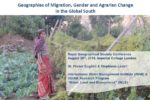 AGRUMIG Policy Brief Series – No. 27: Making agriculture more attractive for youth and women: Evidence from the Republic of Moldova
AGRUMIG Policy Brief Series – No. 27: Making agriculture more attractive for youth and women: Evidence from the Republic of Moldova
The Republic of Moldova is a country with significant potential in agriculture, as it represents a key sector for economic development of the entire state. The national economy largely relies on the agriculture sector in terms of employment, especially in rural areas. The aim of this brief is to present the most recent developments in supporting youth and women to engage in the Moldovan agriculture sector, which were identified during the activities carried out in the framework of the AGRUMIG project. The brief highlights the potential opportunities for returnee migrants, in particular, but also identifies significant existing challenges.
Read more..
 AGRUMIG Policy Brief Series – No. 26: Migration Governance and Agricultural and Rural Change
AGRUMIG Policy Brief Series – No. 26: Migration Governance and Agricultural and Rural Change
In the year 2021/22 alone, over 100,000 labor permits were issued to migrant workers from Madhesh Province for employment primarily in countries of the Gulf Cooperation Council (GCC) and Malaysia. Saudi Arabia and Qatar received the largest number of Nepali migrants from Madhesh Province with 37,822 and 36,358, respectively, in 2021/22. This brief presents key points raised and discussed at a workshop organized in Janakpur, the capital of Madhesh Province of Nepal, on July 12, 2022, on agricultural and rural changes in the context of this high rate of international labor migration from the province. The workshop provided a unique opportunity to bring together farmers, returnee migrants, academics and relevant representatives from the provincial government to generate a dialogue around the divergent outcomes of migrant labor for rural communities, and the barriers and opportunities to harness remittances to support rural development.
Read more..
 AGRUMIG Policy Brief Series – No. 25: Migration governance and agrarian and rural development: Comparative lessons from China, Ethiopia, Kyrgyzstan, Moldova, Morocco, Nepal and Thailand
AGRUMIG Policy Brief Series – No. 25: Migration governance and agrarian and rural development: Comparative lessons from China, Ethiopia, Kyrgyzstan, Moldova, Morocco, Nepal and Thailand
The purpose of this policy brief is to draw together key comparative lessons on different types of migration governance interventions in the AGRUMIG project research regions and examine how they support positive feedback loops between migration and agrarian and rural development. This exploration offers stories of success and omission. Moving beyond the elusive triple-win situation on the benefits of migration for destination and origin countries, migrants themselves and the highly politicized domain of the migration-development nexus, our point of departure is that there are vital prospects for augmenting the positive impacts of migration for societies globally. This brief focuses on how migration governance interventions are potentially useful in maximizing the gains between migration and agrarian development in the sending communities in China, Ethiopia, Kyrgyzstan, Moldova, Morocco, Nepal and Thailand.
Read more..
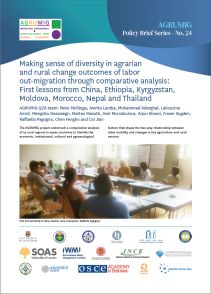 AGRUMIG Policy Brief Series – No. 24: Making sense of diversity in agrarian and rural change outcomes of labor out-migration through comparative analysis: First lessons from China, Ethiopia, Kyrgyzstan, Moldova, Morocco, Nepal and Thailand
AGRUMIG Policy Brief Series – No. 24: Making sense of diversity in agrarian and rural change outcomes of labor out-migration through comparative analysis: First lessons from China, Ethiopia, Kyrgyzstan, Moldova, Morocco, Nepal and Thailand
The AGRUMIG project undertook a comparative analysis of 19 rural regions in seven countries to identify the economic, institutional, cultural and agroecological factors that shape the two-way relationship between labor mobility and changes in the agriculture and rural sectors.
Read more..
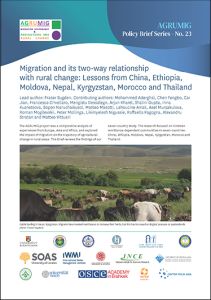 AGRUMIG Policy Brief Series – No. 23: Migration and its two-way relationship with rural change: Lessons from China, Ethiopia, Moldova, Nepal, Kyrgyzstan, Morocco and Thailand
AGRUMIG Policy Brief Series – No. 23: Migration and its two-way relationship with rural change: Lessons from China, Ethiopia, Moldova, Nepal, Kyrgyzstan, Morocco and Thailand
The AGRUMIG project was a comparative analysis of experiences from Europe, Asia and Africa, and explored the impact of migration on the trajectory of agricultural change in rural areas. This brief reviews the findings of our seven-country study. The research focused on 19 remittance-dependent communities in seven countries: China, Ethiopia, Moldova, Nepal, Kyrgyzstan, Morocco and Thailand.
Read more..
 AGRUMIG Policy Brief Series – No. 22: Thailand overview
AGRUMIG Policy Brief Series – No. 22: Thailand overview
The The agriculture sector in Thailand faced a range of challenges due to declining natural resources amid a growing climate change impact. This led to rural households, dominated by small-scale farms, seeking other sources of income, mainly off-farm. Labor migration has become an important strategy to address growing household needs for access to education, healthcare and other services that are not available locally or unaffordable based on agricultural income alone. Men dominate Thailand’s legal immigration flow, yet the number of women migrating for work overseas has recently increased significantly, primarily through unauthorized channels. The top three destinations are Taiwan, South Korea and Israel.
Read more..
 AGRUMIG Policy Brief Series – No. 21: Outmigration and labor mobilityissues and policies in Nepal
AGRUMIG Policy Brief Series – No. 21: Outmigration and labor mobilityissues and policies in Nepal
Nepal’s labor migration history dates back to the colonial period in India when Nepali youths were recruited in the army of the East India Company in the early 19th century, and even prior to this period, Nepali men served in the army of Shikh ruler Ranjit Singh in Punjab (included territories of present-day India and Pakistan). This was followed by seasonal and longer-term labor migration to India. In the last 30 years, migration has reached exceptionally high levels, with the new generation of labor migrants heading to the Gulf States and Malaysia, as well as other destinations such as South Korea, Japan, Poland and Romania. The 1981 Nepali census classified over 400,000 household members as ‘absentees’ (those who were away or intend to be away from home for six or more months) and this increased to about 2.2 million by 2021. The destination of migrants over these years changed considerably. While in 1980, an overwhelming majority (93%) went to India, from the 1990s onwards, this shifted to the Arabian Gulf States and Malaysia, which accounted for over 90% of migrants by the 2010s, with fewer than 10% continuing to travel to India.
Read more..
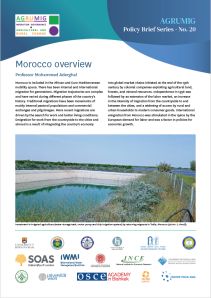 AGRUMIG Policy Brief Series – No. 20: Morocco overview
AGRUMIG Policy Brief Series – No. 20: Morocco overview
Morocco is included in the African and Euro-Mediterranean mobility space. There has been internal and international migration for generations. Migration trajectories are complex and have varied during different phases of the country’s history. Traditional migrations have been movements of mainly internal pastoral populations and commercial exchanges and pilgrimages. More recent migrations are driven by the search for work and better living conditions. Emigration for work from the countryside to the cities and abroad is a result of integrating the country’s economy into global market chains initiated at the end of the 19th century by colonial companies exploiting agricultural land, forests, and mineral resources. Independence in 1956 was followed by an extension of the labor market, an increase in the intensity of migration from the countryside to and between the cities, and a widening of access by rural and urban households to modern consumer goods. International emigration from Morocco was stimulated in the 1960s by the European demand for labor and was a factor in policies for economic growth.
Read more..
 AGRUMIG Policy Brief Series – No. 19: Outmigration and labor mobility issues in Moldova
AGRUMIG Policy Brief Series – No. 19: Outmigration and labor mobility issues in Moldova
The Republic of Moldova is an Eastern European landlocked country where over the past three decades short-term and long-term outmigration has become an important coping strategy, especially for people living in rural areas. Few employment opportunities and low salaries are the main reasons underlying outmigration, with an estimated 984,000 living abroad in 2014. These new waves of migration also affected the agriculture sector, by causing labor shortages, reducing food demand and causing population levels to decrease.
Read more..
- AGRUMIG Policy Brief Series – No. 18: Kyrgyzstan overview
According to the Kyrgyz government, more than a million Kyrgyzstan citizens now live and work abroad with the Russian Federation accounting for over 95% of all migrants and the rest going to Turkey, Kazakhstan, EU countries and the USA. Between 2010 and 2017, the Kyrgyz Republic was consistently ranked among the top five countries in terms of the ratio of remittances to gross domestic product. However, in 2022, the international sanctions regime against Russia led to a drop in migrant remittances. In the same year, for the first time, an agreement was signed with the UK to include Kyrgyzstan in its agricultural work program providing labor for fruit picking. It is now estimated that every fifth employable citizen has migrated from Kyrgyzstan.
Read more..
 AGRUMIG Policy Brief Series – No. 17: Internal migration and agricultural labor mobility issues and policies in Ethiopia
AGRUMIG Policy Brief Series – No. 17: Internal migration and agricultural labor mobility issues and policies in Ethiopia
Ethiopia’s economy is dominated by agriculture, contributing 45% to 50% of gross domestic product (GDP) and employing 70% of the active workforce. Most farming remains characterized by smallholder plots, with rainfed systems predominating, yet increasingly vulnerable because of uncertain rainfall and temperature patterns. In addition, due to a complex of factors, farmland frequently suffers from the depletion of soil nutrients. As a result of too few new jobs and the rapidly expanding economically active population, about two million more people are added annually to the labor market. As a result, there is considerable international migration to the Gulf States, South Africa, Europe and North America. Internal rural-to-urban migration is also common, mainly to major cities and towns, especially to Addis Ababa and other major centers in south and southwest Ethiopia.
Read more..
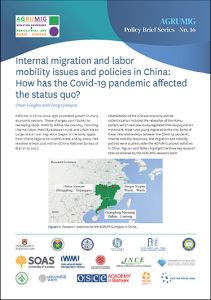 AGRUMIG Policy Brief Series – No. 16: Internal migration and labor mobility issues and policies in China: How has the Covid-19 pandemic affected the status quo?
AGRUMIG Policy Brief Series – No. 16: Internal migration and labor mobility issues and policies in China: How has the Covid-19 pandemic affected the status quo?
Reforms in China since 1978 promoted growth in many economic sectors. These changes contributed to reshaping labor mobility within the country, including internal labor mobility between rural and urban areas. Large-scale rural migration began in the early 1990s from inland regions to coastal areas and by 2020, had reached almost 300 million. Most rural young migrated to the city. Some of these interrelationships between the Covid-19 pandemic, internal mobility responses, and migration and mobility policies were studied under the AGRUMIG project activities in China.
Read more..
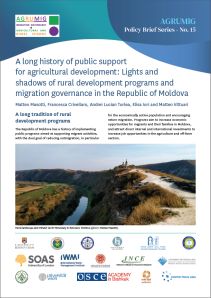 AGRUMIG Policy Brief Series – No. 15: A long history of public support for agricultural development: Lights and shadows of rural development programs and migration governance in the Republic of Moldova
AGRUMIG Policy Brief Series – No. 15: A long history of public support for agricultural development: Lights and shadows of rural development programs and migration governance in the Republic of Moldova
The Republic of Moldova has a history of implementing public programs aimed at supporting migrant activities, with the dual goal of reducing outmigration, in particular for the economically active population and encouraging return migration. Programs aim to increase economic opportunities for migrants and their families in Moldova, and attract direct internal and international investments to increase job opportunities in the agriculture and off-farm sectors. Attention is also given to promoting the tourism sector. This is done in two ways: first, through public incentives for the creation of tourist enterprises, and second, through the promotion of tourism within the country, with a particular focus on encouraging diaspora communities and second-generation migrants.
Read more..
 AGRUMIG Policy Brief Series – No. 14: A country beyond its border: Drivers and impacts of migration in the Republic of Moldova
AGRUMIG Policy Brief Series – No. 14: A country beyond its border: Drivers and impacts of migration in the Republic of Moldova
The Republic of Moldova is a small, landlocked country that, since the late 1990s, has been affected by increasing migration outflows resulting in a massive emigration shock. In the aftermath of independence in 1991, early migratory waves involved workers who had lost their jobs, mostly in the industrial and services sectors. In the ensuing three decades, however, migration has progressively become an option for rural populations as well. Most studies conducted by academic institutions and international organizations emphasize that the most relevant economic factors determining migration are related to low income due to lack of employment and reduced opportunities to improve individual professional or social status.
Read more..
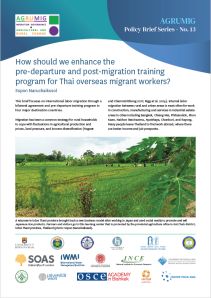 AGRUMIG Policy Brief Series – No. 13: How should we enhance the pre-departure and post-migration training program for Thai overseas migrant workers?
AGRUMIG Policy Brief Series – No. 13: How should we enhance the pre-departure and post-migration training program for Thai overseas migrant workers?
This brief focuses on international labor migration through a bilateral agreement and pre-departure training program in four major destination countries.Migration has been a common strategy for rural households to cope with fluctuations in agricultural production and prices, land pressure, and income diversification. Internal labor migration between rural and urban areas is most often for work in construction, manufacturing and services in industrial estate areas in cities including Bangkok, Chiang Mai, Phitsanulok, Khon Kaen, Nakhon Ratchasima, Ayutthaya, Chonburi, and Rayong. Many people leave Thailand to find work abroad, where there are better income and job prospects.
Read more..
 AGRUMIG Policy Brief Series – No. 12: Gender sensitivity of Ethiopia’s legislation on emigration: Findings and recommendations
AGRUMIG Policy Brief Series – No. 12: Gender sensitivity of Ethiopia’s legislation on emigration: Findings and recommendations
Gender disparities in Ethiopia in terms of education, economics and political participation have been widely observed. The government’s efforts to bring about greater gender equality have been expressed in the National Policy on Women, the National Population Policy, and other national and international laws the country has ratified. To facilitate safe and orderly migration, Ethiopia has adopted various migration laws and policies. However, an analysis of the current legislation shows there is scant mention of gender issues and the inclusion of gender dimensions in the legal frameworks governing migration remains limited.
Read more..
 AGRUMIG Policy Brief Series – No. 11: Labor Shortage and Changes in Land Use Patterns. Experiences from Migrant Communities in Ethiopia and Nepal
AGRUMIG Policy Brief Series – No. 11: Labor Shortage and Changes in Land Use Patterns. Experiences from Migrant Communities in Ethiopia and Nepal
This brief explores how households and communities cope with labor shortages resulting from out-migration and whether labor shortages lead to any changes in land use patterns. These are key questions given concerns about consequences of migration, including land abandonment, in countries like Nepal where the rate of labor migration is high.
Read more..
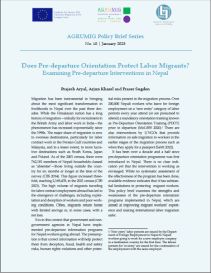 AGRUMIG Policy Brief Series – No. 10: Does Pre-departure Orientation Protect Labor Migrants? Examining Pre-departure Interventions in Nepal
AGRUMIG Policy Brief Series – No. 10: Does Pre-departure Orientation Protect Labor Migrants? Examining Pre-departure Interventions in Nepal
Migration has been instrumental in bringing about the most significant transformation in livelihoods in Nepal over the past three decades. While the Himalayan nation has a long history of migration—initially for recruitment in the British Army and labor work in India—the phenomenon has increased exponentially since the 1990s. The major share of migration is now to overseas destinations, particularly for labor contract work in the Persian Gulf countries and Malaysia, and to a lesser extent, to more lucrative destinations such as South Korea, Japan and Poland.
Read more…
 AGRUMIG Policy Brief Series – No. 9: Applying a Rural Development Lens to Migration Policy in Kyrgyzstan
AGRUMIG Policy Brief Series – No. 9: Applying a Rural Development Lens to Migration Policy in Kyrgyzstan
Development trends in Kyrgyzstan include declining agricultural production, a steady increase in remittances to rural areas from labor migration and an increasing role for the non-agricultural sector in the rural economy. These trends suggest that labor migration is having a transformative effect, with significant opportunities for rural development, but also challenges ahead. Even though migration has a huge impact on the country’s economy (remittances account for some 30% of the country’s GDP), to date migration governance focuses mainly on the rights protection of migrants and does nothing about sending communities and rural development policy. The attractiveness of rural villages for return migration and the well-being of those leftbehind should be a major focus for migration policy along with the inclusion of migration as cross-cutting issue in rural development policy at all levels.
Read more..
 AGRUMIG Policy Brief Series – No. 8: Mainstreaming the needs of migrant children and sending communities into the rural schools development agenda in Kyrgyzstan
AGRUMIG Policy Brief Series – No. 8: Mainstreaming the needs of migrant children and sending communities into the rural schools development agenda in Kyrgyzstan
Many studies indicate that labor migration is the main economic survival strategy for all population groups in Kyrgyzstan, but especially young people. Migration affects rural schools in several ways. Young people are not interested in fully completing their secondary education, and after the 9th grade, many drop out of school and start looking for jobs. This problem is compounded by the shortage of school teachers in the country. According to the Ministry of Education and Science of the Kyrgyz Republic, teaching vacancies in subjects such as computer science, English, biology, chemistry, mathematics and physical education have not been filled for years in many schools. Recent university graduates are not interested in filling these vacancies as labor migration offers a more favorable way of entering the labor market.
Read more..
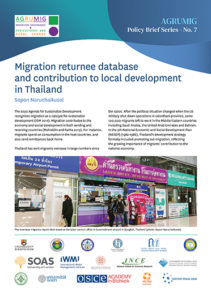 AGRUMIG Policy Brief Series – No. 7: Migration returnee database and contribution to local development in Thailand
AGRUMIG Policy Brief Series – No. 7: Migration returnee database and contribution to local development in Thailand
The 2030 Agenda for Sustainable Development recognizes migration as a catalyst for sustainable development. Migration contributes to the economy and social development in both sending and receiving countries. For instance, migrants spend on consumption in the host countries, and also send remittances back home. Thailand has sent migrants overseas in large numbers since the 1970s. After the political situation changed when the US military shut down operations in Udonthani province, some 100,000 migrants left to work in the Middle Eastern countries including Saudi Arabia, the United Arab Emirates and Bahrain. In the 5th National Economic and Social Development Plan (NESDP) (1982-1986), Thailand’s development strategy formally included promoting out-migration, reflecting the growing importance of migrants’ contribution to the national economy.
Read more..
 AGRUMIG Policy Brief Series – No. 6: Migration and COVID-19 in context: Labor migration in Ethiopia and its implications for policy responses
AGRUMIG Policy Brief Series – No. 6: Migration and COVID-19 in context: Labor migration in Ethiopia and its implications for policy responses
The COVID-19 pandemic has drastically affected global mobility since its outbreak in early 2020. It has taken the lives of millions and led to wholesale changes at all levels in the way people interact, move and work. By mid-March 2022, at least 476 million people had contracted the infection, and some six million died from COVID-19. Among those most affected by the pandemic have been migrants, often from communities that were already vulnerable due to having limited economic, social and other resources at their disposal to be able to establish resilience and overcome shocks to household livelihoods. This brief examines the effects of COVID-19 on labor migration in Ethiopia as well as the government’s responses to these effects and their implications.
Read more..
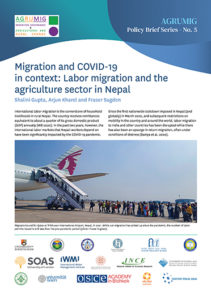 AGRUMIG Policy Brief Series – No. 5: Migration and COVID-19 in context: Labor migration and the agriculture sector in Nepal
AGRUMIG Policy Brief Series – No. 5: Migration and COVID-19 in context: Labor migration and the agriculture sector in Nepal
International labor migration is the cornerstone of household livelihoods in rural Nepal. The country receives remittances equivalent to about a quarter of its gross domestic product annually. In the past two years, however, the international labor markets that Nepali workers depend on have been significantly impacted by the COVID-19 pandemic. Since the first nationwide lockdown imposed in Nepal (and globally) in March 2020, and subsequent restrictions on mobility in the country and around the world, labor migration to India and other countries has been disrupted while there has also been an upsurge in return migration, often under conditions of distress.
Read more..

- AGRUMIG Policy Brief Series No. 4:
COVID-19 and Migration Uncertainty in Kyrgyzstan: To Leave or Stay and Earn?
Kyrgyzstan is one of the most remittance-dependent countries in the world. However, the global coronavirus disease (COVID-19) pandemic has severely affected remittance slows to low and middle-income countries (LMICs) generally, and remittance-dependent economies such as Kyrgyzstan have found themselves deeply vulnerable.
Read more..
- AGRUMIG Policy Brief Series – No. 3
The Precarity of Transnational Migration and the Covid-19 Pandemic: Addressing Female Return Migration in Kyrgyzstan and Tajikistan.
Read more..
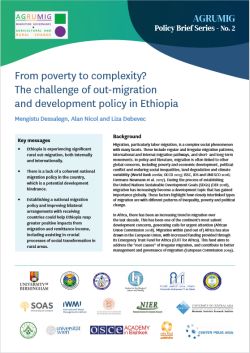
- AGRUMIG Policy Brief Series – No. 2
Migration, particularly labor migration, is a complex social phenomenon with many facets. These include regular and irregular migration patterns, international and internal migration pathways, and short- and long-term movements.
Read more..
 AGRUMIG Policy Brief Series – No. 1
AGRUMIG Policy Brief Series – No. 1
Unprecedented levels of migration in today’s globalized economy are dramatically reshaping social, economic and political landscapes in sending and receiving countries.
Read more..









